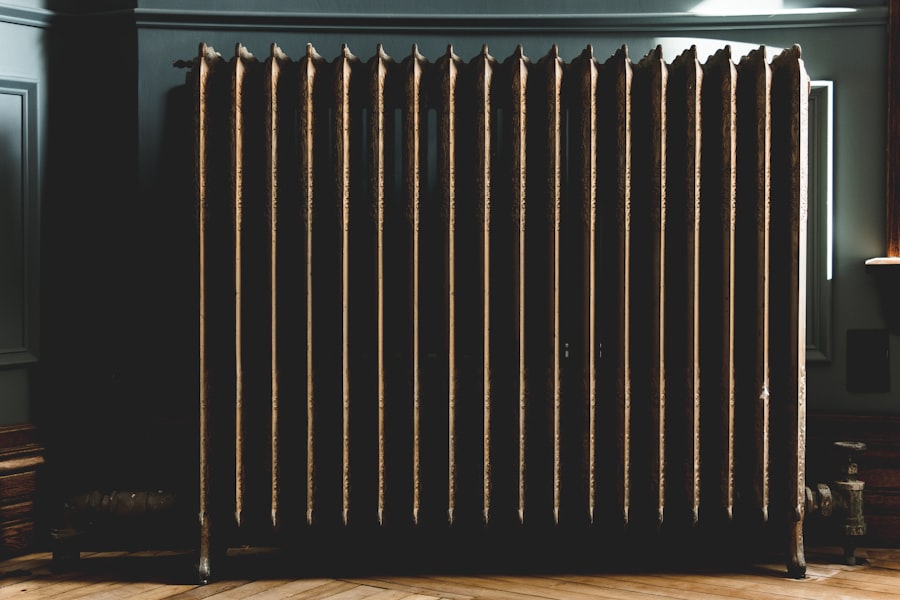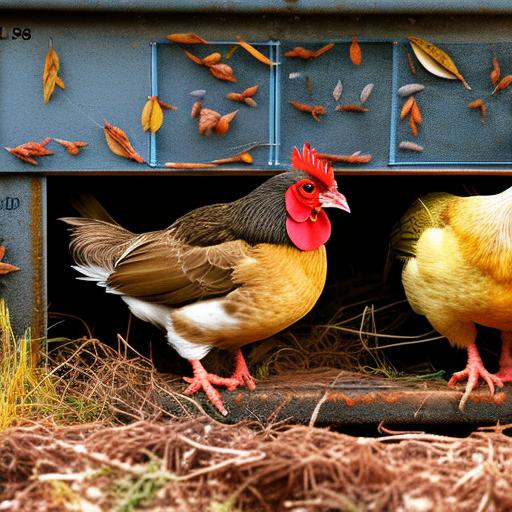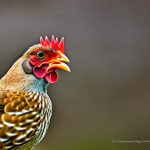Keeping chickens warm during the winter months is crucial for their health and comfort. Chickens are sensitive to cold temperatures and can suffer from frostbite, respiratory issues, and even death if not properly cared for in cold weather. In this blog post, we will discuss various ways to keep your chickens warm and cozy during the colder months.
Key Takeaways
- Proper coop design is crucial for keeping chickens warm in winter
- Insulation is key to maintaining warmth in the coop
- Choosing the right bedding material can help regulate temperature and moisture
- Proper ventilation is necessary for balancing warmth and fresh air
- Regular monitoring of flock health and comfort is essential for winter care
Understanding the Importance of Coop Design
The design of your chicken coop plays a significant role in keeping your chickens warm. A well-designed coop should provide insulation, proper ventilation, and protection from the elements. Insulation helps to retain heat and prevent drafts, while proper ventilation ensures good air quality and prevents moisture buildup.
Insulation: The Key to Keeping Chickens Warm
Insulation is essential for keeping your chickens warm and preventing heat loss. There are several types of insulation that you can use in your coop, including fiberglass, foam board, and straw bales. Fiberglass insulation is a popular choice as it is easy to install and provides excellent thermal resistance. Foam board insulation is another option that is lightweight and provides good insulation value. Straw bales can also be used as insulation by stacking them around the coop walls.
When installing insulation in your coop, it is important to cover all walls, ceiling, and floor to prevent heat loss. Make sure to seal any gaps or cracks where cold air can enter. It is also important to consider the safety of your chickens when using insulation materials. Avoid using materials that can be easily pecked or ingested by the chickens.
Choosing the Right Bedding Material
Choosing the right bedding material is crucial for keeping your chickens warm and dry. Bedding helps to insulate the coop floor and provides a comfortable surface for the chickens to walk on. There are several bedding options available, including straw, wood shavings, and sand.
Straw is a popular choice as it provides good insulation and absorbs moisture well. However, it can become damp and moldy if not replaced regularly. Wood shavings are another option that provides good insulation and absorbs moisture. Sand is a good choice for coop floors as it drains well and is easy to clean.
When choosing bedding material, consider the needs of your chickens and the climate in your area. Some bedding materials may be more suitable for colder climates, while others may be better for warmer climates.
Proper Ventilation: Balancing Warmth and Fresh Air
Proper ventilation is necessary for maintaining good air quality in your coop. While it may seem counterintuitive to let cold air into the coop during winter, it is important to balance warmth and fresh air. Poor ventilation can lead to a buildup of ammonia from chicken droppings, which can cause respiratory issues.
To ensure proper ventilation, make sure your coop has vents or windows that can be opened and closed as needed. It is important to keep these openings clear of obstructions such as bedding or debris. You can also install a ventilation system that includes fans or vents to help circulate air.
Winterizing Your Chicken Coop

Winterizing your coop involves preparing it for the colder months. This includes sealing drafts, adding extra insulation, and protecting against moisture buildup. Inspect your coop for any cracks or gaps where cold air can enter and seal them with caulk or weatherstripping. Make sure all windows and doors are properly sealed.
Adding extra insulation to your coop can help retain heat and prevent drafts. This can be done by installing additional insulation in the walls, ceiling, and floor. You can also use draft stoppers or blankets to cover windows and doors at night.
To prevent moisture buildup in your coop, make sure there is proper drainage around the coop and that the roof is in good condition. Remove any wet bedding or droppings regularly to prevent mold and bacteria growth.
Heating Options: Pros and Cons
While heating your coop may seem like a good idea, it can be dangerous and expensive. Heating devices such as heat lamps or heaters can pose a fire hazard if not used properly. They can also cause overheating or burns to the chickens if they come into direct contact with them.
Instead of relying on heating devices, focus on providing proper insulation and ventilation in your coop. This will help to retain heat and prevent drafts, while still allowing for fresh air circulation. If you are concerned about extreme cold temperatures, you can provide additional heat sources such as heated perches or heated waterers.
Feeding Strategies for Cold Weather
Feeding your chickens properly during winter is crucial for their health and warmth. Cold temperatures increase the energy requirements of chickens, so it is important to provide them with high-energy foods. This can include grains, seeds, and high-protein feeds.
Adjusting feeding times can also help to keep your chickens warm. Feeding them in the evening allows them to digest the food overnight, which generates heat and helps to keep them warm. Make sure to provide fresh water at all times, as chickens need water to stay hydrated and regulate their body temperature.
Watering Your Chickens in Winter
Keeping your chickens hydrated during winter can be challenging. Freezing temperatures can cause water to freeze, making it inaccessible to the chickens. It is important to provide water that is not frozen and easily accessible.
One option is to use heated waterers that prevent water from freezing. These devices have built-in heaters that keep the water at a constant temperature above freezing. Another option is to provide warm water several times a day and remove any ice that forms in the waterers.
Monitoring Your Flock’s Health and Comfort
Monitoring your flock’s health and comfort is essential during winter. Cold temperatures can increase the risk of respiratory issues, frostbite, and other health problems. Keep an eye out for signs of illness, such as coughing, sneezing, or lethargy. If you notice any signs of illness, consult a veterinarian for proper diagnosis and treatment.
It is also important to monitor your chickens’ comfort levels. Make sure they have enough space to move around and roost comfortably. Provide additional perches or heated perches to give them options for staying warm. Regularly check the coop for any drafts or leaks and make necessary repairs.
In conclusion, keeping your chickens warm during winter requires proper coop design, insulation, bedding, ventilation, winterizing, feeding, watering, and monitoring. By following these tips, you can ensure your chickens stay healthy and comfortable throughout the colder months. Remember to always prioritize the safety and well-being of your flock when making any changes to their environment.
If you’re looking for the best way to keep your chickens warm during the colder months, you’ll definitely want to check out this informative article on Poultry Wizard. They provide valuable insights on creating a cozy and insulated farmhouse chicken coop that will keep your feathered friends comfortable and protected from the elements. From choosing the right materials to implementing proper ventilation, this article covers all the essential tips and tricks for maintaining a warm and inviting space for your chickens. Don’t miss out on this valuable resource, click here to read more: https://poultrywizard.com/keeping-chickens/farmhouse-chicken-coop/.
FAQs
What is the best way to keep chickens warm during cold weather?
The best way to keep chickens warm during cold weather is to provide them with a well-insulated coop that is free from drafts. You can also use heat lamps or heated waterers to help keep them warm.
What temperature range is ideal for chickens?
Chickens are comfortable in temperatures ranging from 50 to 80 degrees Fahrenheit. However, they can tolerate temperatures as low as 20 degrees Fahrenheit as long as they have a warm and dry place to roost.
What are the signs of hypothermia in chickens?
The signs of hypothermia in chickens include lethargy, loss of appetite, shivering, and a drop in body temperature. If you suspect your chickens are suffering from hypothermia, move them to a warm and dry place immediately.
Can I use a space heater to keep my chickens warm?
It is not recommended to use a space heater to keep your chickens warm as it can be a fire hazard. Instead, use heat lamps or heated waterers that are specifically designed for use with chickens.
How often should I clean my chicken coop during the winter?
You should clean your chicken coop at least once a week during the winter to prevent the buildup of moisture and bacteria. This will help keep your chickens healthy and comfortable.
Meet Walter, the feathered-friend fanatic of Florida! Nestled in the sunshine state, Walter struts through life with his feathered companions, clucking his way to happiness. With a coop that’s fancier than a five-star hotel, he’s the Don Juan of the chicken world. When he’s not teaching his hens to do the cha-cha, you’ll find him in a heated debate with his prized rooster, Sir Clucks-a-Lot. Walter’s poultry passion is no yolk; he’s the sunny-side-up guy you never knew you needed in your flock of friends!







